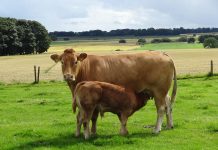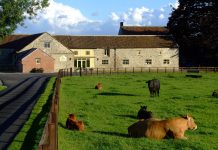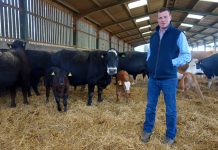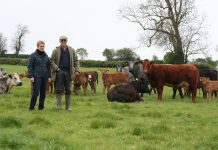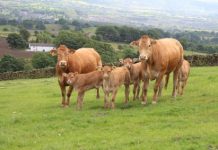A family producing store cattle in north-east England has been using the Limousin as a crossing sire for two decades.
Kevin Sparke and his family manage 1,000 acres of grassland at Little Swinburne, near Hexham. The farm carries a herd of 175 Limousin and Belgian Blue cross suckler cows, as well as around 780 Texel cross Mule ewes, which go to the Texel tup.
Four generations of Sparkes live on site. Kevin and his wife, Sarah, are in partnership with Kevin’s father Colin and his mother, Pat. Also living on the farm are Kevin’s grandparents, Reg and Mary. Kevin and Sarah have two small children, Michael, who is five, and one-year-old Imogen.
The family took on the tenancy of Little Swinburne 12 years ago, after leaving a 500-acre farm situated 30 miles away. The move has allowed them to expand their 70-strong suckler herd to the current numbers. Their main income from the cattle is through the sale of 8-14 month old store calves at Carlisle auction mart.
The Sparkes also have a small contracting element to their business, baling and handling silage for some of their neighbours. They themselves bring in a contractor for forage harvesting. Meanwhile, Sarah’s family run the local agricultural merchants, JS Hubbuck, and she also helps out with the paperwork at the company.
The family picked the Limousin because they believe the breed excels as a terminal sire. Occasionally, a small number of Limousin cross Friesian heifers are bought in, and these are put back to the Limousin. They also run a Belgian Blue stock bull.
One bull which has produced some good calves is Hafodlas Ali, purchased at Carlisle in May 2006 for 7,000gns. He is by Cloughhead Royal and out of Hafodlas Oona, coming from AH and GW Roberts, Hafod Las, Ysbyty Ifan, Betws-Y-Coed.
Keskadale Cosmos from Keith and Mark Harryman’s herd near Keswick in Cumbria joined the team in 2009 with another bull, Keskadale Eyeful, purchased this spring. Both are sired by Snoopy.
“Cosmos has proved to be a very good buy; he combines heavy muscling with ease of calving. He also has a great temperament,” says Kevin. “I like a bull which is long and shapely, with clean lines. I do take account of EBVs, but I would rather trust my eye, than look at liveweight gain figures. They can vary greatly, depending on the management system. I am convinced that a bull that is brought on slowly will last longer.
“Limousins have plenty of milk, and that is another reason why we like them. They are an essential element of our farming strategy, which is to produce a top quality suckler calf. Trade has improved recently, and we feel the business is on a sound footing. Nevertheless, the cost of feed and fertiliser has rocketed, and we need consistently good prices to allow for reinvestment.
“Our type of cow is not too big and she also needs to be stylish and have correct legs. Durability is a major consideration. Traditionally, our cows would produce about eight calves for us over their lifetime. But the rising cull price has persuaded me to sell some of the older cows, so the average will have dropped recently. Good temperament is another vital issue, particularly as we have small children.”
The Sparke family manage their cows in separate batches, with one group calving in March and the other in May. A third, smaller group is rolled over to September. The plan is to have calves to sell throughout the year, to improve cash flow, with six to eight sold at a time, to spread risk.
Both straw-bedded sheds and cubicles are utilised for housing. The March calving group calves inside on straw, remaining in the building until May. They are fed a mix of silage and straw, topped up with vitamins and minerals. An injection is given to reduce the risk of calf scour, which has been a problem in the past.
The March calvers are turned out with their progeny in May, and run on grass plus creep feed all summer. They are weaned at housing, which usually takes place during early to mid-November.
The May calvers winter in cubicles that were installed last autumn, to save on straw costs. Their calves are taken off them the following April, when they go outside, ready to calve again. May-born calves are creep fed using a bought-in pellet, as well as being given access to silage.
“The cubicles have saved us from buying around 400 bales of straw,” Kevin comments. “At £10/bale, that represents a significant saving. We have a diet feeder, but we have nowhere to store straights, so we only use it for mixing silage, hay and straw. We regard straw as a very important element in the diet, as well as for bedding, and we make around 1,500 bales a year, which we buy in the swath.
“We need as much grass as we can get to maintain our current stocking rate, which is why we do not grow any arable crops. All our hay and silage is made from early to mid-June, with one large cut and a second, smaller cut that is hopefully of high quality.
“Total mixed ration feeding is a useful tool, but we are in a rather isolated area, so haulage is a big concern. The one advantage that bought-in concentrates offer is consistency of quality.”
Normally, all the autumn calvers would be left outdoors. However the weather has been so poor recently (Summer & Autumn 2011) that they are now brought in for a couple of days, when they are due to give birth. The herd has very few calving problems, and it is rare to find an animal which requires a caesarean.
Many of the stores from the Sparkes’ farm go to a finisher based in Yorkshire, who seeks out their cattle at the sales. While they do not set out specifically to breed show calves, a few have gone on to a career in the show ring, and the family find it very rewarding when their livestock perform well after they leave the farm.
This autumn, a heifer and a bullock were sold at Carlisle mart at an average £1,105 apiece. Other notable prices this year were paid for a group of six 10-12 month old calves, with bidding averaging £1,250.
The time available for showing is limited nowadays, but a trip to a Leyburn Auction Mart Show and Sale has reaped rewards in the past. The Sparkes won a red ticket for a Limousin cross steer, which later sold for £1,650.
The farm was invited to join this year’s Higher Level Scheme. It was chosen largely because it is the site of Little Swinburne Tower, a fifteenth century pele tower, or fortified keep. They had hoped to qualify earlier, but applications were closed, due to restricted funding. The limitations of the HLS are few, with just a handful of stone walls to repair and a slight restriction on grazing the moss land.
As for plans for the future, the Sparkes have only been farming the land for just over a decade. The move to their present location has allowed them to significantly increase their herd, with greater selection potential. The sole focus for the cattle enterprise now is to continue to improve the quality of the female line and invest in the best bulls they can afford. They are happy to continue being patient, until they are in a position to move towards keeping a higher percentage of pedigree Limousins in their herd.
Kevin joined the British Limousin Cattle Society as a member in spring 2011 and would like to market breeding bulls at premier sales in the future. At present he just has the one pedigree heifer, Keskadale Elaine, a Linarn Unique daughter who has been put to Keskadale Eyeful. “I would need to join the herd health scheme to take it further, but as I only have one pedigree animal it is not realistic at present. However it is certainly something to aim for in the future,” he says.
Says Kevin: “We are hoping that our pedigree heifer will have a female calf, so that we can keep her for breeding. Our long term aim is to breed pedigree Limousin bulls of a high standard. We also want to be able to produce uniform batches of calves, which look pleasing to the eye.
“We may not end up with all the cows registered, because we feel the Limousin is also a good choice for putting to our Belgian Blue cross females. It produces a calf which, in my opinion, is very hard to beat.”











